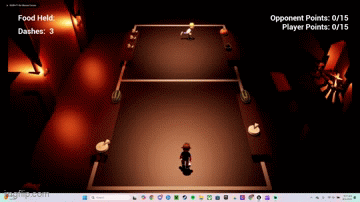Food Fight
Lead Designer & Project Manager
Food Fight is a third-person sports/arcade style game. In this project I worked as the Lead Designer as well as project manager where I used tools such as Jira and Perforce, as well as keeping our Game Design Document up to date. This game was created in Unreal Engine 5.3.
Introduction
Food Fight was my Capstone Project to finish my time at Full Sail. Every student created an idea and prototype to submit, but only a handful were chosen. Food Fight was one of these projects.
I wanted to create a game that would standout from the rest. I created a game idea that reflected my love for classics and arcade games, and made Food Fight.
Project Breakdown
-
Sports/Arcade game
-
Prototype timeline: 2 weeks documentation, 2 weeks building
-
Group timeline: 3 months, half time (4-5 hours/day)
-
Focus on creating an alpha build
-
Scripting of AI, hit registration, and on-hit mechanics
-
Team:
-
Myself
-
Riley Strobbe
-
Lloyd Teague
-
Simon McEntire
-
-
Marketplace assets used
-
Alien Stylized Characters
-
Cute Clay Character
-
Low Poly Asteroids
-
Low Poly Spaceship
-
And More
-
Overview
Level Progression

Between each level, player will be taken back to the Overworld/Level Select
Completing the Platform Level unlocks the special (optional) Dark Level
Features/Mechanics

Standard Food
There are multiple different types of food to throw in Food Fight. Standard Food types are food that do no include a status affect and primarily score points for the throwing player.
The Food Tray is also used to deflect incoming food and score points for the deflecting player.
Status Food
Status Food types are food that score points as well as having a secondary effect. These are introduced progressively after the Platform Level. These include Moldy Cheese (3 hits = -1 point), Ice Cream (freezes hit player), Mashed Potatoes (blinds player), and Sticky Pudding (slows player on hit or when walking over puddle).



Level Start Screen
Each level begins with a screen similar to the ones above. The explain some of the narrative as the player progresses.
These start screens also tell the player about a new food type being introduced (left) or recurring shown in that level (right). This helps the player develop a strategy priory to the match starting.
Level Mechanics
Most levels feature a unique mechanic that the player must learn, practice, and master during that level. In the Dark Level, the players are in a haunted mansion where the lights mysteriously turn on and off. The player is able to see a highlight off pick-up food as well as themselves and their opponent, but not the food that is flying toward them.

Preproduction
Level Layouts
The standard top-down maps weren't very useful in an arena style game like Food Fight, so we developed these level layouts to help us plan out where food should spawn, what the player and opponent player spaces should look like, and how to incorporate level mechanics in the most meaningful way.
Documentation

Design Pillars
Design Pillars were created when developing the prototype in order to establish an overall aesthetic for the game. This helped later when guiding the team in order to keep the game true to it's original idea.
Reference Deconstruction
In order for the game to succeed, I wanted to have a solid reference deconstruction on games that inspired this project. Here, I deconstructed "Super Dodge Ball (NES)" as it was the main inspiration for Food Fight. This nine page document covers rules, mechanics, features, game modes, character stats, and even character metrics and states.
Full documentation of Design Pillars, Reference Deconstruction, and a Feature Breakdown of Food Types can be found here:

Reflection
Food Fight is my biggest project to date, and I'm very proud of what my team and I were able to accomplish. This is by no means a complete project though, and I do intend to come back to this project. Here is a breakdown of my work.
Level Progression - In it's current state, the level progression works fairly well. We've given no reason for the player to go to the Dark Level (secret level), nor any special prize for completing it. When the game grows, we will add more reason for the player to go here as well as any other future secret levels.
Food Types - During the brainstorming process, there were many more food types that were designed but were scrapped during development due to time constraints and to not overwhelm those who were playtesting for the first time. In the future, we plan to include more food types, such as the Golden Cookie: a homing projectile that gives 5 points, but has a small chance of spawning.
Multiplayer - This game would work so well in a multiplayer/co-op setting, but this was against our guidelines during production. We have some simple ways of adding this as we develop further, and are excited to see what avenues this would open.
Overall, I learned so much about the production process and how to manage a team. In fact, I fell in love with managing projects. Being able to collaborate, listen to others, encourage people to think outside of the box and grow themselves was fun and fulfilling. I also learned how difficult production can be when under strict timelines, and how to pivot when needed or find creative solutions to problems without throwing the whole project off track. This was my favorite project I've gotten to work on, and hope to work on more just like it in the future.













